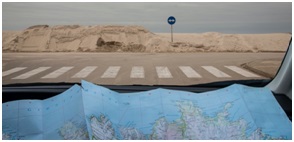A Coaching Model By Shawn Harvey, Life Coach, CANADA
Life is like a road trip, and road trips are awesome until they are not. When it comes to road trips, the journey and the destination are equally important. Where you are going and how you get there matter, and the same is true in life.
How the Journey Model Significance in Life Decision Making
Detours come up while on the road trip of life, and without the proper support, they prevent you from getting to your destination. Preparation can get you so far, then navigating and responding to the obstacles in your path takes over. With exceptional support from a coach, you can navigate through these obstacles creating a memorable trip.
Some detours can be planned for miles in advance, while others are unforeseen and require quick reactions. That is why I use a journey model. Just as there are multiple observable steps to a journey, the same is true about our daily lives. These steps include acknowledging your starting place and destination, mapping the route, navigating detours, and course corrections along the way. The journey model is set up for significant shifts or decisions in life and is also very scalable to help with more minor changes.
Two backpackers were making their way across Ireland when they came across a farmer working in his field. “Excuse me, sir, how do you get to Dublin?” The farmer looked up and replied, “If Dublin is where you’re headed, I wouldn’t be starting from here.”
Starting places and destinations are linked. We need to know where we are starting from and where we are headed to plan a good trip. Depending on the journey, it might be easier to see the destination first; therefore, these first two stages are interchangeable.
Acknowledging Your Starting Place & Determining Destination: Discovering Your Values
My wife has always told me dreaming comes before planning. It is why the first step in the Journey Model deals with the destination. The destination becomes the motivation to persevere.
If you want to build a ship, don’t drum up the men to gather wood, divide the work and give orders. Instead, teach them to yearn for the vast and endless sea. Antoine de Saint-Exupery[i]
When a destination comes into focus, the journey becomes purposeful. Simon Sinek describes this in Start with Why[ii] when contrasting two bricklayers, one who is begrudging a job that he will not finish in his lifetime and another who knows he is building a cathedral. Although the work will not be done in his lifetime, he has played a part in a larger vision.
The destination is a created future, somewhere you intentionally want to be, do, and feel. Your values and dreams play a crucial role in a created future that is obtainable.
Your level of peace, fulfillment, and the energy with which you live your life will depend on how well-matched your values are to the life you are living. Being clear on our values allows us to create an energizing vision for life and the strategy and action steps to move in the direction of that vision. If someone is uncertain about their values, we recommend they start with Discovering Your Values[iii].
Mapping The Route
Once we know where we are and where we are going, it is time to map the route to get there. Mapping involves deciding what to say yes or no to. It is also a time to set up some mile markers to know whether you are heading in the right direction. Without clarity, there is no guarantee that your actions will get you to where you want to be. Preparation can get you so far, then navigating and responding to the detours in your path takes over.
Navigating Obstacles
Some detours can be planned for miles in advance, while others are unforeseen and require quick reactions. The main thing is to identify the obstacle. Once known, we can determine how to navigate. When someone cannot identify what is blocking their path, we use the imagery of five different types of detours: Fog, Ditches, Ruts, Crossroads, and Autopilot.
Those words create different imagery for different people. If they don’t help with the conversation, we can talk through the meaning I have placed on the terms to help initiate brainstorming.
Fog refers to the directionless feeling, forgetting where you are, or even who you are, in the midst of the journey.
 Ditches. The higher you go in leadership, the narrower the road gets and the deeper the ditch. Some of the dangerous parts are not the obvious ones, but the unassuming places. That is why we need personal guardrails. Guardrails are a barrier set up in a safe zone that prevents us from entering a disaster zone.
Ditches. The higher you go in leadership, the narrower the road gets and the deeper the ditch. Some of the dangerous parts are not the obvious ones, but the unassuming places. That is why we need personal guardrails. Guardrails are a barrier set up in a safe zone that prevents us from entering a disaster zone.
Driving should be effortless, so when we seem to be fighting the vehicle to head straight down the road, typically, it is rutted pulling us to the side. The ruts in the road cause us to use more energy to get to where we want to be. The same is true when you are living outside of your values. Misalignment creates an internal conflict that pulls us to the side. We want to be home with the family in the evenings, yet work demands we stay late—the desire to go on that trip while trying to save for retirement. Ruts are the breeding ground of resentment. Being caught between conflicting values continuously causes tension in situations where none should exist. You can’t enjoy your journey because of the conflict at the moment.
 Crossroads, stop sign, T-intersection, and no road markers. In the pre-Garmin/iPhone era, if you didn’t have an accurate map, that next turn could either get you to your destination or give you a long, costly delay. Some people would prefer to go quick when they hit a crossroad, believing that movement is progress. But the movement in the wrong direction is time-consuming and, if it happens too often, demoralizing. A coach helps you evaluate the situation and gives you confidence that your route will get you to where you want to go.
Crossroads, stop sign, T-intersection, and no road markers. In the pre-Garmin/iPhone era, if you didn’t have an accurate map, that next turn could either get you to your destination or give you a long, costly delay. Some people would prefer to go quick when they hit a crossroad, believing that movement is progress. But the movement in the wrong direction is time-consuming and, if it happens too often, demoralizing. A coach helps you evaluate the situation and gives you confidence that your route will get you to where you want to go.
Autopilot, in 2017, Lexus came out with a commercial[iv] contrasting the experience of driving with being driven by an autonomous car. The tagline: “Enjoy the thrill of driving while you still can.” Life, as with driving, is meant to be a thrill. When things become so routine that you can go through the motions of your day while not experiencing the emotions, autopilot has taken over.
Life is supposed to have ups and downs, joy and grief. When monotony happens, the spark required to make life worth living diminishes. Socrates said, “the unexamined life is not worth living,” neither is the unintentional life. A coach helps you find a new adventure and chart your course to personal fulfillment.
Course Corrections
On any long journey, course corrections may be required. Coaching is the outside voice to help evaluate that everything is going smoothly and to cheer on the progress that has been made.
Whether it is help finding out where you are at, a tow to get out of a ditch, a realign with your destination, or directions to get you back on track, the Journey Model helps. Because everyone deserves to have the tools to live their fullest life.
References
[i]Antoine de Saint-Exupery is credited with this quote but on further examination, it is most likely a paraphrase of a quote from his 1948 book Citadelle translated into English.
[ii]Sinek, S. (2011). Start with Why: How Great Leaders Inspire Everyone to Take Action (Illustrated ed.). Portfolio.
[iii] Discovering Your Values is a 7-part video series with worksheets to help clarify your Values and Dreams. DYV and other bundles
[iv]“The 2017 Lexus IS”